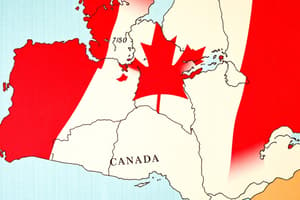Podcast
Questions and Answers
What was the main reason behind the proposal to unite the colonies in British North America?
What was the main reason behind the proposal to unite the colonies in British North America?
- To establish a common language
- To create a new legal system
- To form a stronger military alliance
- To increase trade and strengthen economies (correct)
What factor added urgency to the proposal for unity among the colonies?
What factor added urgency to the proposal for unity among the colonies?
- Religious conflicts among the colonies
- Economic sanctions by the UK
- Political unrest within the colonies
- Fear of invasion or annexation by the US (correct)
What was the outcome of the Quebec City conference regarding the wider union of the colonies?
What was the outcome of the Quebec City conference regarding the wider union of the colonies?
- The conference ended without reaching any conclusion
- The colonies decided to remain independent
- The proposal for a wider union was rejected
- It was decided that a wider union would make all colonies stronger and more prosperous (correct)
What did the Quebec resolutions lead to?
What did the Quebec resolutions lead to?
What was the significance of the British North America Act?
What was the significance of the British North America Act?
Who became the first Prime Minister of Canada after the British North America Act came into effect?
Who became the first Prime Minister of Canada after the British North America Act came into effect?
What was one of the economic struggles faced by Canada in the 1860s?
What was one of the economic struggles faced by Canada in the 1860s?
What led to government deadlock in the province of Canada?
What led to government deadlock in the province of Canada?
What was the primary reason for proposing the union of the Canadian colonies?
What was the primary reason for proposing the union of the Canadian colonies?
What was one of the main concerns that prompted the urgency for the unity of the Canadian colonies?
What was one of the main concerns that prompted the urgency for the unity of the Canadian colonies?
What event led to the creation of the plan for Confederation?
What event led to the creation of the plan for Confederation?
What was the significance of the Quebec resolutions?
What was the significance of the Quebec resolutions?
Who became the first Prime Minister of Canada after the British North America Act came into effect?
Who became the first Prime Minister of Canada after the British North America Act came into effect?
What was the outcome of the negotiations over the rules of the new country?
What was the outcome of the negotiations over the rules of the new country?
Which event led to a second conference in Quebec City, where Newfoundland representatives joined?
Which event led to a second conference in Quebec City, where Newfoundland representatives joined?
Flashcards are hidden until you start studying
Study Notes
- In the 1860s, Canada was known as British North America, composed of seven colonies and two territories.
- Economic struggles ensued due to decreased exports to the UK and the US becoming more powerful.
- Uniting the colonies was proposed to increase trade and strengthen economies.
- The province of Canada was deeply divided over politics, language, and religion, causing government deadlock.
- Fear of invasion or annexation by the US added to the urgency for unity.
- Maritime colonies proposed a conference to discuss forming a new country, which the province of Canada joined.
- During the conference, it was decided that a wider union would make all colonies stronger and more prosperous, resulting in the plan Confederation.
- Negotiations over the rules of the new country led to a second conference in Quebec City, where Newfoundland representatives joined.
- After 15 days of debates, a list of resolutions was created, but not all colonies approved.
- The Quebec resolutions were turned into a bill, called the British North America Act, which was approved by the British Parliament and came into effect on July 1, 1867.
- Sir John A. Macdonald became the first Prime Minister of Canada.
- The British North America Act is still an essential part of Canada's Constitution, despite the country's growth and changes since 1867.
Studying That Suits You
Use AI to generate personalized quizzes and flashcards to suit your learning preferences.




